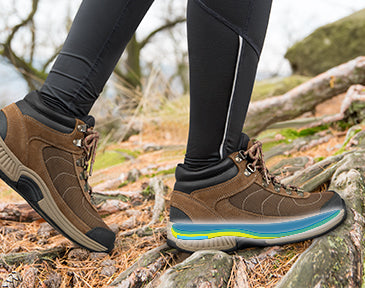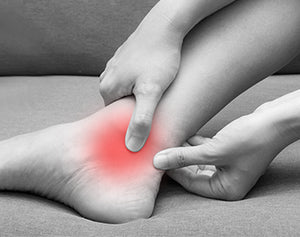The Orthofeet Blog
- All Posts
- All
- Arch Support
- Back Pain
- Bunions
- Diabetes
- Flat Feet
- Foot Pain
- Hammer Toes
- Heel Pain
- Heel Pain/ Heel Spurs
- Knee & Hip Pain
- Knee pain
- Morton Neuroma
- Orthopedic shoes
- Other
- Overpronation
- Plantar Fasciitis
- Swollen Feet
Plantar Fasciitis


Josh White DPM / August 12, 2021
Hiking with Plantar Fasciitis: What You Need to Know
Hiking with Plantar Fasciitis: What You Need to Know
Read Post-
Flat Feet Overpronation Causes, Treatment and Prevention
Medical information provided by Steven Gershman DPM / November 28, 2022So, you are about to purchase new shoes and have heard about neutral vs. overpronation shoes. Which do I buy? Which is better? What do I need? Does it really matter? Let's start with a short tutorial on what exactly is pronation, what causes overpronation, and why it even matters. What is pronation? Pronation is actually a 3-plane motion of the foot that begins at the sub-talar joint under the ankle. Mainly it involves the heel rolling inwards or medially, the arch drops and the foot becomes looser or more flexible. It is an important and normal component of the gait cycle, beginning when the heel contacts the ground. When there is too much pronation (as in many things too much can be bad for you), too little or abnormal pronation, problems can arise. For more insights on the differences between excessive and insufficient pronation, check out the article overpronation vs underpronation. What is the reason the foot pronates? There are two main reasons for pronation. When the foot pronates, it provides natural shock absorption. This is the most important reason the foot pronates. Pronation makes the foot go from fairly stiff as it hits the ground, to looser and more flexible as it fully contacts the ground. This provides shock absorption so the back, knees and feet aren’t hit with the full impact of the body weight hitting the floor. This loosening of the foot also allows the foot to be able to adapt to uneven surfaces as we walk or run. What causes overpronation of the foot? By far the number one cause of overpronation is loose hypermobile feet. Basically, if you start with loose joints in your feet you will pronate too much. This excessive pronation can lead to a foot problem and issues in the lower leg. Loose feet are generally a result of loose ligaments. Ligaments go from bone to bone crossing joints and are what hold the foot together. When they are too loose or stretched out, they allow too much motion throughout the foot. The foot becomes almost like a loose bag of bones. Loose ligaments are usually something you are born with but can also occur after pregnancy or certain injuries. In addition, overpronation can occur with some congenital foot deformities or after an injury that damages bones or joints. What are the consequences of overpronation? Sometimes nothing! Many people overpronate and never even know it or suffer any damage or symptoms of it. On the other hand (or foot), some people suffer multiple injuries including: Tendon overuse injuries Inflammation pain Fatigue Joint damage Arthritis Ankle sprains Slow chronic changes in foot structure leading to bunions and hammertoes Nerve injuries Overpronation Treatment and Prevention Assuming you are suffering from pain caused by overpronation, reducing it should be very helpful. The best way to diagnose whether your foot, leg or back issues are from overpronation is via a trained professional evaluation. Any of these problems could be from overpronation, but they could also be due to something else entirely. The best treatment for overpronation related pathology is orthotics for overpronation which are specially made insoles that are inserted inside the shoe. To truly stop overpronation and treat the associated problems arising from it is best to couple custom orthotics with a men's or woman's overpronation shoes, also known as motion control shoes. In reality you are not just treating overpronation but controlling the underlying cause and the associated injury or pathology. This requires a well-made shoe and an orthotic. They work synergistically. Orthotics for overpronation should have the following features: Anatomical arch support that aligns the body and keeps the foot in a ‘neutral position’ Deep heel cup that cradles the foot and reduces pressure under the heel Ample cushioning to absorb and disperse shock forces from heel to toe What is an overpronation shoe? Generally, it is a shoe that first and foremost is a motion controlling shoe, as pronation is motion. The shoe needs to be stable and firm with a solid heel counter (the piece in the back of the shoe) to control heel motion that is a major component of pronation. This stability helps reduce conditions like heel pain, ankle pain, and knee pain. In addition, the midsole (the material between the outer sole and the shoe itself) needs to be firm and usually have extra firm material on the medial side or inside. This design is crucial for reducing excessive pronation, which can lead to issues like shin splints, arch pain, and heel spurs. Many companies have their own unique patented add-ons to better control motion. All these add-ons are geared to stopping the overpronation while still allowing normal amounts of pronation, which helps maintain healthy foot posture and foot function. Orthofeet shoes are biomechanically designed with orthopedic insoles that provides the optimal level of arch support and helps prevent the foot from excessively rolling inwards. This fundamental feature positions the foot correctly which in turn aligns the hips, knees and legs, minimizing injuries and providing total body pain relief. Constructed with a thick layer of foam, Orthofeet overpronation shoes provide exceptional cushioning from the ball-of-foot through the heel area for all day comfort and protection. This comfort is beneficial for those with foot pain or conditions like flatfoot. The lightweight ergonomic sole improves mobility and smooths every step you take. We also offer arch support inserts for men and women shoe inserts to provide extra support, ensuring you get the right level of comfort and stability tailored to your needs. Combined with orthotics they provide the best control of motion even with severe flat foot. It is also important to remember to replace your shoes often as the shoe ages it loses its motion control ability. Shoes should be replaced at least once a year or more often in hard use. Other Recommendations for Overponation Treatment Rest: Allow your feet time to recover from strain or injury caused by overpronation. Strengthening exercises: Strengthen your foot muscles through toe curls, heel raises, and other exercises to improve foot support, stability and shock absorption. Avoid walking barefoot: Always wear proper fitting and supportive shoes for proper foot health Limit high-impact activities: Avoid running or other high-impact sports unless you have a specific overpronation running shoe For more shoe collections designed for you, consider checking out our various collections for additional options. These include women's wide shoes, arch support shoes, men's walking shoes, shoes for flat feet and plantar fasciitis shoes. Each collection offers shoes specifically designed to support different foot conditions, providing a wide range of solutions for your needs.Read More








